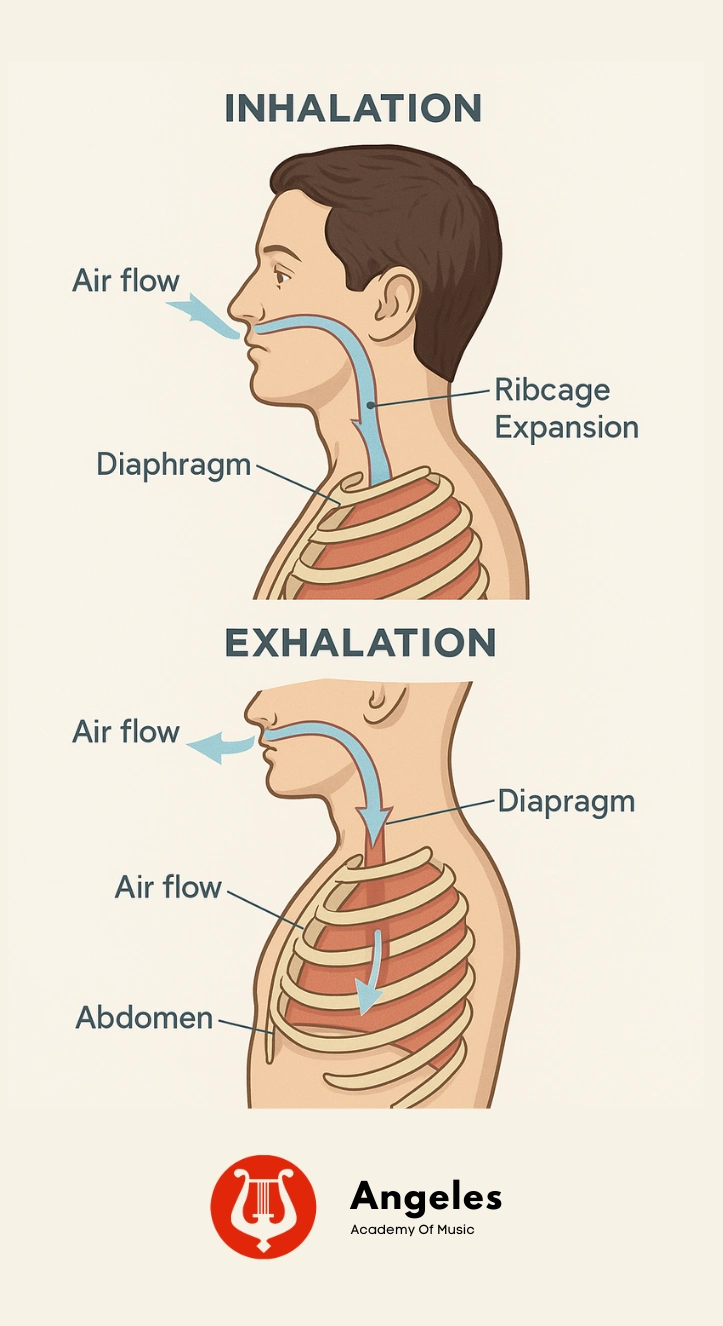Learning how to sing in tune is essential for any singer. It’s what makes melodies flow smoothly and feel satisfying to hear. When your voice matches the intended pitch, your performance sounds more musical and confident. In fact, singers who consistently hit their notes feel empowered and can connect better with an audience.
Most “off-key” or wrong pitch singing stems from either lack of ear training or practice or technique, not a fixed disability. With the right approach, you can learn to sing on pitch. We will discuss how you can train all 3 in this article.
Why Pitch Accuracy Matters
Singing in tune isn’t just a technical goal. It transforms your musicality and makes it more fun to sing. An in-tune voice is a muscle memory that comes from multiple practice sessions of rehearsing different sets and sequences of notes.
You get the melody sound right, blending nicely with instruments or other singers. That boosts performance confidence: you won’t be second-guessing every note, so you can relax and connect with the song.
When you or your child sing accurately, the audience hears the emotion and expression, not the flaws.
Over the long term, good intonation (consistent pitch) opens doors to harmony singing, auditions, and learning challenging songs. On the other hand, singing flat or sharp can create dissonance and frustration.
The goal here is not perfection. It’s to sound pleasant!!! Even Freddie Mercury or Adele had moments where they missed a note (as live singers occasionally do), and they worked hard to minimize those slips.
Remember: perfect pitch 100% of the time is biologically impossible, but improving your pitch accuracy will not just make you sound better, but make singing more enjoyable for you also.
Busting the “Tone-Deaf” Myth
Here’s a big misconception I hear from students: “I’m tone-deaf.” The truth? Almost nobody is. Only about 4% of the population has true amusia (the scientific term for tone-deafness). If you can tell when “Happy Birthday” sounds off-key, your ears work just fine.
So what’s the issue? For most beginners, the ears know the note, but the vocal cords don’t respond accurately. It’s not a defect. It’s a skill gap. With practice, the brain learns to send better instructions, and the voice learns to follow.
Imagine your ear is the GPS giving directions, and your voice is the driver. At first, the driver keeps missing turns. But give them enough practice, and they’ll get you to the right street every time.
So, for beginners who ask: How do I sing in tune if my voice keeps going flat? The answer is practice, not genetics.
How Your Voice and Brain Make Pitch
Your voice isn’t magic. It’s plumbing. Tiny wet strings (your vocal folds) vibrate as air blows past them. Tighter strings = higher notes. Looser strings = lower notes. Simple.
But here’s the problem: your brain is like that friend who swears they know how to parallel park… until they try. Your ear hears the note. Your brain says, “Cool, we got this.” And then your vocal folds smash into the curb.
That’s why practice matters. You’re training a coordination loop between ear, brain, and throat. Missed pitch isn’t proof you “can’t sing.” It’s proof your voice hasn’t practiced enough darts throws yet.
And for the more curious (scientific) minds...
As you sing different vowels or words, your vocal tract shape (the mouth, throat, tongue position) changes resonance and can slightly shift pitch perception. Also, breath pressure can affect pitch stability: uneven airflow will make your notes wobble.
That’s why many beginners struggle with learning how to sing high pitch without strain.
And that’s why solid breath support (steady diaphragm engagement) is crucial for steady pitch.
On top of that, our brains perceive pitch logarithmically: each semitone (half-step) is 100 “cents.” Tiny deviations (even 20–50 cents) can sound off-pitch to a trained ear.
Using a visual tuner app lets you see these cents differences in real time, which can be a powerful learning tool.

Core Techniques That Actually Work
1. Pitch Matching
This is the foundational skill. Practice listening to a single note (on a piano, phone app, or guitar) and then singing that exact pitch back. Hold the pitch and use a tuner or instrument to check if you’re flat or sharp. Adjust your voice until you line up perfectly.

For parents helping kids: just pick a familiar tune (“Happy Birthday” works) and see if they can match the starting note when you sing it together.
Free tuner apps (like Tuner Ninja or Vocal Pitch Monitor) play a note and show you if your voice is sharp or flat.
2. Intonation: Connecting the Dots Without Tripping
Anyone can sing one note. The trainwreck happens when you string notes together. That’s intonation. Sliding between pitches (sirens) or practicing scales is like training wheels.
Or vocalizing major triads (three-note scales like “do-mi-sol”) helps. Major triads span an octave and force you to hit specific intervals – root, third, and fifth. Singing triads up and down alerts you to any flat/sharp tendencies and builds coordination.
Over time your intonation will improve as your vocal folds learn to jump accurately from note to note.
3. Ear Training & Audiation: Hear It Before You Say It
They audi-what? Audiation: hearing the note in your head before you sing it. It’s like mentally humming the tune so your voice knows where to land. Solfege (do-re-mi) feels cheesy until you realize it’s secretly Jedi training for pitch.

Great singers don’t just guess. They train to sing on pitch consistently by practicing solfege and interval drills.
Don’t know solfege? Start simpler. Before singing a line, hum it in your head. Then sing it out loud. Compare.
YouTube has plenty of free “ear training” videos where you repeat back notes like a call-and-response.
Parents: encourage kids to sing along with cartoons or jingles, if they can hum a commercial tune on pitch, they’re already building audiation.
App suggestions: EarMaster, Perfect Ear, SoundGym
4. Breath Support: Your Battery Pack
Most beginners think bad pitch comes from “bad ears.” Often it’s just bad air. Weak breath = shaky tone = wobbly pitch. Breath control is what allows you to sing at high pitch without sounding squeaky or strained.
Use diaphragmatic breathing (expand your belly on inhale) to give your sound power. If your breath is weak or uneven, the tone will wobble and the pitch will drift. Practice slow, deep breaths and make sure you have enough air to sing phrases fully. This support lets you maintain a consistent tone so you can control pitch, especially on sustained or high notes.
We have an entire article on breathwork. Check it here: Breathing Techniques for Singing.

5. Relaxation: Tension Is the Silent Pitch Killer
You know how your voice goes higher when you panic? Yeah, that’s tension. Tight throat, jaw, or neck muscles drag your pitch all over the place. Loosen up. Yawn, stretch, , whatever keeps you from singing like you’re holding your breath during a horror movie.
6. Onsets: How You Start Matters
A harsh, choked “attack” on a note will send you sharp before you even get rolling. Aim for gentle, balanced starts. Think of it like landing a plane: smooth touchdown > chaotic crash.
Instead of slamming into a note, sneak into it. Say “hoo” or “ah” softly, then grow stronger. If you start smooth, the pitch is easier to land.
Daily Exercises That Actually Help…
Look, singing exercises can feel goofy. But goofy works. Here are a few that actually make you better (and yes, one involves a straw):
- Single-Note Matching: Play one note. Sing it. Or use a tuner app. If the needle swings too much, adjust until it chills.
- Triad Sliding: Practice singing a root-3rd-5th triad on a vowel. For instance, sing C–E–G (then G–E–C) using solfege Do–Mi–Sol. Listen carefully for any spot where you go off. You can even do this with a piano: play each note then sing it back. This helps you feel the jump between notes and correct any drift. (Tip: Stand up tall, stay relaxed, and avoid tension as you go.)
- Solfege Scales: Sing scales using solfege syllables (Do, Re, Mi, etc.) in movable-Do style. For example, sing “Do-Re-Mi-Fa-So” on any starting pitch. This links your ear to the scale degrees. Have a friend play the scale on an instrument or use an app to guide you. Over time, solfege trains your brain to anticipate each interval, improving overall accuracy.
- Interval Recognition: Play or hum two notes (like a 2nd, 3rd, or 5th apart) and try to sing them back. Check if you got them right. You can also sing a note and then try to sing a certain interval above it (for example, “sing this note, now sing a perfect 4th above it”). This drill sharpens your sense of distance between pitches.
Pro Tip: Want to test whether you’re singing on pitch or not quickly? Hum into a straw or try sliding up scales until you reach your ceiling. This is how you train “safer” high pitch singing.
Spend 5–10 minutes daily on these. Think of it as brushing your vocal teeth. Not glamorous, but it prevents musical cavities. For more on how to train better to sing, check out our article on Vocal Warmups.
Helping Young Singers: Advice for Parents
Every child progresses at their own pace. If your child has been taking lessons for a few weeks or even months but still misses notes, don’t panic or assume something is wrong.
Don’t expect your child to have singing with perfect pitch after a few months. Progress is about developing relative pitch first. First few weeks may just be the beginning. Consistency and encouragement are key.

Focus on whether they are gradually improving their ear (even tiny improvements count). Celebrate when they hit a hard note correctly, even if other notes are still shaky. Kids (and beginning teens) are still developing both ear and vocal control, so patience is crucial.
Tips:
- Keep practice short and fun. 10 minutes > one exhausting hour.
- Celebrate the tiny wins (one clean scale = high five moment).
- Set realistic expectations. Mastering pitch is about communication, [not just] perfect notes. Focus on expressing the song; hitting every note perfectly takes time.
- Choose a supportive teacher.
A good voice teacher will tailor lessons to your child’s level and give them tools to improve. (Angeles Academy is proud to offer some of the best singing lessons in Los Angeles with experienced instructors.)
Adult Beginners: It’s Never Too Late
Worried about starting as an adult? Don’t be! Adult brains are still quite adaptable. Many of my adult students started in their 40s or later and learned to sing on pitch.
It’s a myth that singing is only for the young. In fact, an adult’s discipline and life experience can make practice very productive. Also, adults often have stronger reading and analytical skills to grasp concepts like music theory and intonation rules.
Also, many ask: How do you sing in tune if you’ve never done it before? The answer is ear training plus consistent daily practice. It works at any age.
Check out our blog: Is Too Late for Singing Lessons? for more on adult learning.
Final Thoughts
Singing on pitch is a skill that develops over time. Almost all singers have to work at it, and even famous ones do occasional retakes. With regular practice and good habits, however, you will improve.
A singing teacher can make a huge difference. They’ll give personalized feedback and keep you motivated. If you’re ready to take your singing seriously, consider taking private lessons. Angeles Academy of Music’s voice lessons offer structured training on all these techniques, from ear training to breath support.
Above all, be patient and positive. Celebrate small victories (correct pitch on a hard note) and learn from off-key moments.
With consistent work, you can find your pitch center and master how to sing in tune.
Contributed by: Marina G, (BM, UCLA: University of California Los Angeles, Vocal Performance) (Angeles Academy of Music - Senior Voice Instructor)
.svg)
.svg)
.svg)
.svg)
.svg)
.svg)
.webp)




.svg)